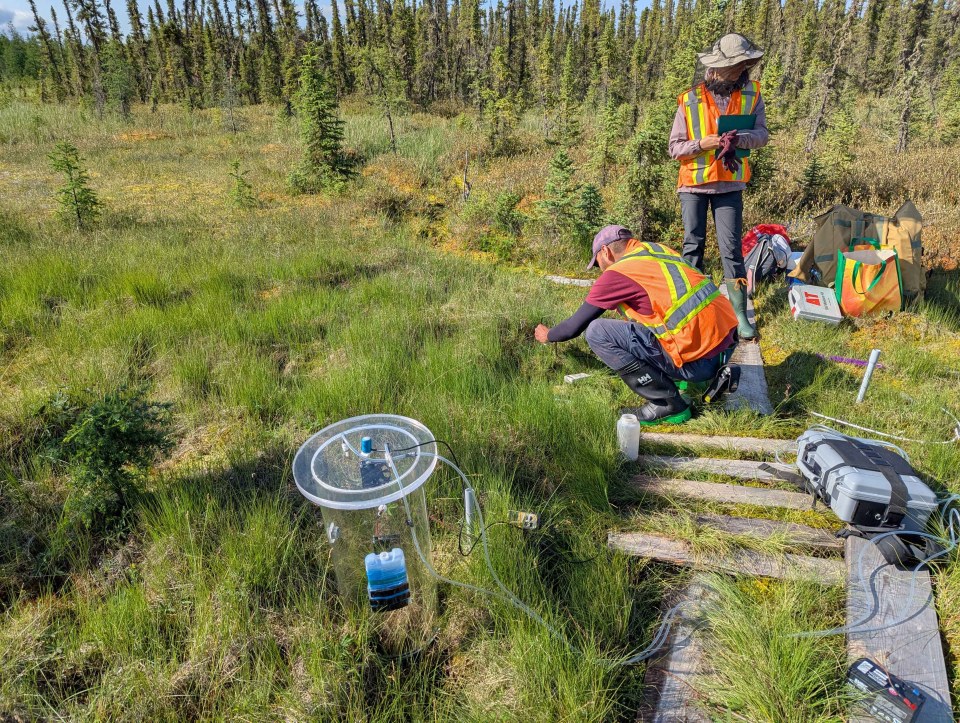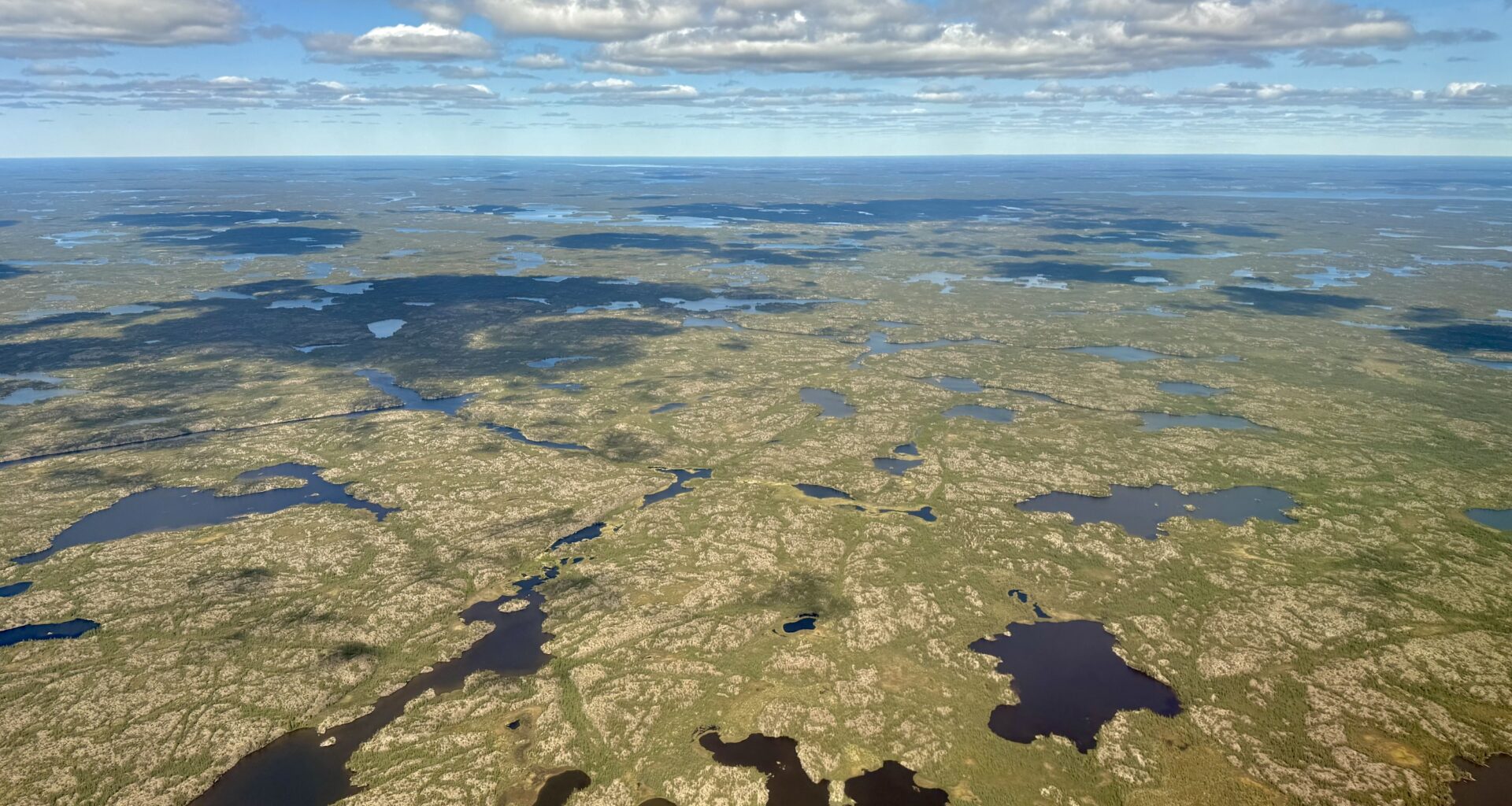Louie Beaulieu, a trapper who worked in forestry for more than 50 years, has noticed the effect of the NWT’s drought on the land where he lives in Fort Smith.
Beaulieu just came back from his cabin. Where the lake is normally high, he said, this year the creeks are all dried out.
“The water table is about six feet lower than normal. Never seen that for years. I’ve never, ever seen that,” said Beaulieu.
“Even the muskegs – like the big muskegs that used to be full of water – you can walk across them just about anywhere now.”
Since the drought began impacting creeks, rivers and muskeg, he’s noticed the muskrats have moved elsewhere and the beavers soon followed.
For the NWT government’s 2024 Forest Health Report, published last month, researchers were only able to survey about one third of the area they would normally study.
Smoke from nearby wildfires reduced visibility for crews on the ground and in the air, making it difficult for researchers to do their work.
Even so, one of the report’s findings is the sheer impact of a drought that has covered much the NWT since June 2022 – and its effect on forests.
Of about four million hectares of forest surveyed by researchers in 2024, more than 220,000 hectares showed stresses from either the ongoing drought or the high water of 2020 and 2021, the report asserted. Because the survey work was limited by factors like smoke, researchers think the real extent of the issue “is likely substantially larger.”
In the North Slave, for example, the report found “large areas of black spruce
decline northwest of Lac La Martre extending to the Sahtu border, and jack pine mortality growing on shield rock and in exposed areas along the Ingraham Trail.”
“It is extremely likely that mortality exists and is going unsurveyed in the surrounding landscape in both areas,” the report continued.
“In fact, it is suspected much of the shield in the North and South Slave regions may have experienced similar jack pine mortality including the East Arm of the Great Slave Lake.”
Drought can contribute to tree and plant mortality, which in turn creates fuel for wildfires. An extreme drought, researchers said, makes extremely hot and fast-moving crown fires more likely, and those fires can be difficult or impossible to control.
While droughts have occurred in the NWT over the past 30 years, the report describes the current conditions as an “exceptional event,” the full effect of which will become more visible in the years to come.
Experts say that while the trend over recent years indicates climate change will bring more extreme swings between dry and wet weather, the NWT’s drought has changed forests across the territory in big and small ways.
Drying of the landscape
The latest water monitoring bulletin published by the territory’s Department of Environment and Climate Change earlier this month found the amount of precipitation to fall in August was mostly well below average, while the temperatures that month were mostly well above average.
The bulletin found water levels were below average in many of the NWT’s major bodies of water like Great Slave Lake, Great Bear Lake and the Slave, Hay and Mackenzie rivers. There are just a few exceptions – like the South Nahanni, Snare, Taltson, Lockhart and Hoarfrost rivers – where water levels were either average or above average for the monitoring period.
These low water levels, which can also be seen in ponds and creeks, have now existed for years.
Droughts are a normal feature of the boreal forest and most species can live with a period of low water, the NWT’s Department of Environment and Climate Change stated, but a prolonged drought like this one can push some animals and plants beyond their usual limits. (The department declined a request for an interview with authors of the latest forest report, but answered questions over email.)
“An extended and severe drought is likely to impact amphibians that rely on wetlands and moist habitats, beavers and muskrats that rely on aquatic systems for shelter and food, and moose, which are sensitive to heat and water scarcity,” the department told Cabin Radio by email.
“Drought can also decrease forage quality for moose. Caribou may also be impacted as lichen-rich habitats may degrade under drought and an increased incidence of wildfire. Birds are also likely to be impacted by drought, particularly those that nest or feed in wetlands.”
Effect of low water flow
David Olefeldt, a professor in the University of Alberta’s Department of Renewable Resources, has been studying muskeg and peatlands in the NWT for the past 10 years.
He leads a monitoring program in the Dehcho and South Slave regions that studies the effect of permafrost thaw, wildfires, and cycles of drought and flood on greenhouse gases and carbon balance in these wetlands – and how those factors influence the water chemistry in the creeks and rivers that drain the muskeg.
“The last three summers have been extremely dry in the Dehcho and South Slave but prior to that, we had three really wet years, so it’s not like we’ve been on a constant drying trend,” said Olefeldt.
“It’s more increased variability and wetness from year to year. It’s hard to say what next year will bring.”
The dry conditions over the past few years have resulted in low water flow from muskeg to streams and rivers, Olefeldt has observed. This means water in streams largely comes from deeper groundwater sources and doesn’t pick up as much sediment and organic matter, making streams appear clearer, without the brown and yellow colour that is typically associated with swampy wetlands.
“In some ways, that can sound like you’re having improved water quality, but really that’s not the case, because these ecosystems, they’re adapted to the type of water that would be normal when wetlands are connected,” Olefeldt said.
This, he said, can change the way species interact through the likes of prey and predator interactions. Low water can also affect the migration of fish and other creatures.
Olefeldt thinks at least a year or two of wetter-than-normal weather will be needed to re-establish the usual river flow.
 Two undergraduate students measure greenhouse gas emissions using a soil chamber, a way of assessing how drought is affecting the greenhouse gas balance of peatlands. Photo supplied by David Olefeldt
Two undergraduate students measure greenhouse gas emissions using a soil chamber, a way of assessing how drought is affecting the greenhouse gas balance of peatlands. Photo supplied by David Olefeldt
Olefeldt has found that permafrost in the NWT makes peatlands more resilient to drought as it impedes a degree of water movement. This has prevented some areas from drying out and releasing carbon stores held in these lands.
However, he notes that permafrost is disappearing “relatively quickly” in southern parts of the territory due to climate change.
When wildfires – which have been worsened by the drought – roll through peatland, the areas are usually dry enough to allow for the growth of species that readily burn like black spruce.
“Even though they’re wetlands, they actually burn quite severely,” said Olefeldt.
“When they do burn, they release more carbon from combustion, because the peat soil stores all this soil carbon and it’s combusted.”
A ‘strategic game of chess’
The NWT’s wildfire agency is tasked with understanding and adapting to the effect of drought on the territory’s landscape and how fire interacts with it.
Richard Olsen, fire operations manager at NWT Fire, said the lack of rain across the territory has had a big impact on crews’ ability to combat wildfires.
“In a typical season – several years ago – we would have seen several days or weeks of drying, and then you’d get a rain event. And the rain event would have five, 10, upwards of 25 ml, and it would tend to keep things damp on occasion,” Olsen said.
“But we’re seeing now situations where we could go for 30 days or longer without any real significant rain.”
This, Olsen said, allows for fuels like trees and brush to dry out, and reduces – or altogether eliminates – wetlands that would have otherwise acted as a natural fire break.
“In some of these big wet prairie systems, the water has dropped right down. You can literally walk through areas that used to be ponds, and they’re now just dry mud flats,” said Olsen.
“Any kind of grass or vegetation that’s associated with those, in addition to just being dry, carry fire through those types of areas.”
In some ways, Olsen said, fire behaviour hasn’t changed. It can be predicted based on the interaction between fuels, weather and topography.
“The basic science around how things ignite, and how they start and how they burn, hasn’t really changed. But that being said, the individual inputs – especially as it comes to kind of the weather and the fuel – are certainly pushing things towards more extreme type fire behaviour,” said Olsen.
In wetter years, such as before the current drought began in 2022, Olsen said he’d seen fires remain relatively contained, without growing more than a couple hectares, and fewer fires in general.
“We have to, in the last couple of years, be a lot more careful on fires that might just get simply larger, because there’s no hindrance to them getting big, and we have to look a lot farther out from communities in terms of where the kind of risk might be over an entire season for a fire that’s growing,” said Olsen.
He said he’s seen these fires, some of which burn deeper in the soil than normal and require more work to put out, become a threat to communities “quite unlike we’ve ever seen before.”
In the past decade or so, fires have also challenged the traditional notion that recently burned areas act as a natural fire barrier.
“Since 2013, and [20]14, we’ve seen that some of these areas are not just having fires go through them, but they’re really prone to reburning,” said Olsen.
In recent years, Olsen has seen the fire season grow longer, beginning earlier in the spring and lasting well into September, as well as some fires that overwinter between seasons under the cover of snow.
This, he said, puts strain on staff resources and crews who have to complete training sooner and work later into the year.
What makes responding to these fires even more difficult, Olsen said, is that fires like these aren’t unique to the NWT.
“When Canada as a whole starts to have those kind of conditions and require significant resources, it really plays into the ability of us and others to come to each other’s aid and share resources,” said Olsen.
“We got to a point, literally, where there were no resources available within Canada, very limited resources available through the [United] States, because they also were having their own fire behaviour conditions.”
As the changing climate continues to alter the natural environment, people will have to continue to adapt to these changes, Olsen said. He argues part of that is accepting fire as a natural and essential part of the landscape.
“If we continue to see fire as a threat entirely, and move towards trying to extinguish everything, we take out that ecological function, and we really start to add more fuel to potential future fires,” he said, “to a point where it may be that we’ve just created a condition where we’ve made a fire even worse than it would have been if we would have had some kind of fire on the landscape.”
At the same time, Olsen said considerable effort is put into understanding what should be protected from fire on the landscape, with human life (including the safety of firefighters) taking priority, as well as communities, homes and other infrastructure.
Thirty-two four-person crews are the backbone of the territory’s wildland firefighting force. Olsen says Ottawa is investing in more Firesmarting, community fire management capacity, and research into fire behaviour like “short interval reburns,” in which fires burn through the same place twice in quick succession.
“There has to be some kind of balance between fire’s natural role and what we can do to protect the values that are important to people in the NWT,” Olsen said, adding that available resources have to be used in a calculated way, increasingly so as fires become bigger, more intense and requiring more effort to get under control.
“It’s almost like a strategic game of chess,” he said, “where you really have to know all the pieces, where you try and put them all in the right spot.”
Related Articles

















